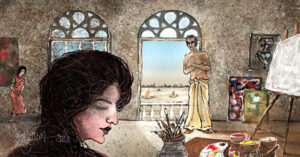Sumerian Mythology
Underworld: Gang wars are older than you think
There were two sisters who hated each other: Inanna who ruled the world, land of the living, and Ereshkigal who ruled the underworld, land of the dead. Inanna decided to visit the underworld. She told the gatekeeper of the underworld that she wanted to attend her brother-in-law’s funeral rites. But perhaps she actually wanted to conquer the underworld. Before she left, Inanna instructed her minister Ninshubur to plead with the gods Enlil, Nanna, and Enki to save her if anything went wrong, and dressed elaborately for the visit. Her garments, unsuitable for a funeral, along with her haughty behaviour, made the queen of the underworld suspicious.
Following Ereshkigal’s instructions, the gatekeeper told Inanna she could enter the first gate of the underworld, but she had to hand over a piece of clothing. She asked why and was told, ‘It is just the way of the Underworld’. She obliged.
Inanna passed through a total of seven gates, each time removing a piece of clothing or jewellery she had been wearing at the start of her journey. When she arrived in front of her sister, she was stark naked and vulnerable. Ereshkigal turned Inanna into a corpse and hung her on a hook.
Three days and three nights passed and Ninshubur, following instructions, went to Enlil, Nanna, and Enki’s temples and demanded they save the goddess of life, love and living. The first two gods refused, saying it was her own mess, but Enki was deeply troubled and agreed to help. He created two sexless figures (neither male nor female). He instructed them to appease Ereshkigal and, when she asked what they wanted, ask for Inanna’s corpse and sprinkle it with the food and water of life.
Things went as Enki said and the two sexless beings were able to revive Inanna. But Ereshkigal’s demons followed Inanna out of the underworld and said she wasn’t free to go until someone took her place. They first came upon Ninshubur and asked her to take Inanna’s place. Inanna refused, saying she had helped her as she had asked. They next came upon Dumuzi, Inanna’s husband. He was enjoying himself though his wife was supposedly still missing in the underworld. Inanna wasn’t happy and said the demons could take him. Dumuzi tried to escape his fate but a fly told Inanna and the demons where he was. It was then decreed that Dumuzi would spend half the year with Ereshkigal in the underworld, and the rest of the year with Inanna.
Japanese Mythology
The first couple: When a lovelorn husband followed his wife to the land of the death
The primal human couple, Izanagi, the man, and Izanami, the woman, were responsible for churning out islands from the sea which they populated with their children, the many deities who populate the Japanese countryside. Izanami died while bearing the fire-god and Izanagi was so distraught that he was determined to bring her back. So he went to Yomi, the shadowy land of death, to fetch his wife. Unfortunately, Izanami had eaten the food of Yomi and so could never return.
Izanagi lit a torch, desperate to see his wife. To his horror, he found that her once beautiful body had decayed and was covered with maggots. He ran out of the underworld in fear, chased by Izanami who missed her husband and wanted him to stay. Izanagi finally reached earth and covered the entrance of the underworld with a huge boulder. His angry wife yelled, “I will kill a thousand living creatures each day.” Izanagi yelled back, “Then I will create 1,500 new lives each day.” So the story ends in eternal separation and bitterness.
Abrahamic Mythology
Original Sin: Of Adam, Eve, an apple and a slithery snake
God created the world out of nothingness in six days and rested on the seventh day. He created the first man, Adam, in his own image, and the first woman, Eve, from Adam’s rib. He told Adam and Eve to enjoy the wonderful Garden of Eden, but not to eat the fruit of the Tree of Knowledge. That was the Forbidden Fruit! Adam and Eve obeyed God, but the Devil, in the form of a serpent, enchanted Eve and got her to take a bite of the Forbidden Fruit. She then convinced Adam to eat it too. Suddenly, innocence was gone. The humans became aware of their nakedness and tried to cover themselves. God was disappointed with his creations and cast them out of Eden for this original sin, the first act of disobedience. He also decreed that woman would be answerable to man, and that the children of Adam and Eve — all of humanity — would pay for this sin.
Various schools of Jewish, Christian and Islamic thought disagree on details of this story. Jewish folklore describes the fruit as a pomegranate. Christian folklore describes it as an apple. In Arabic folklore, it is the banana, for they equated India with its silks and spices as the land of Eden.
While Original Sin is a key theme in Christian mythology, in Islamic mythology, Allah forgives Adam and Eve and there is no concept of original sin or carrying forward of sins to the next generation.





